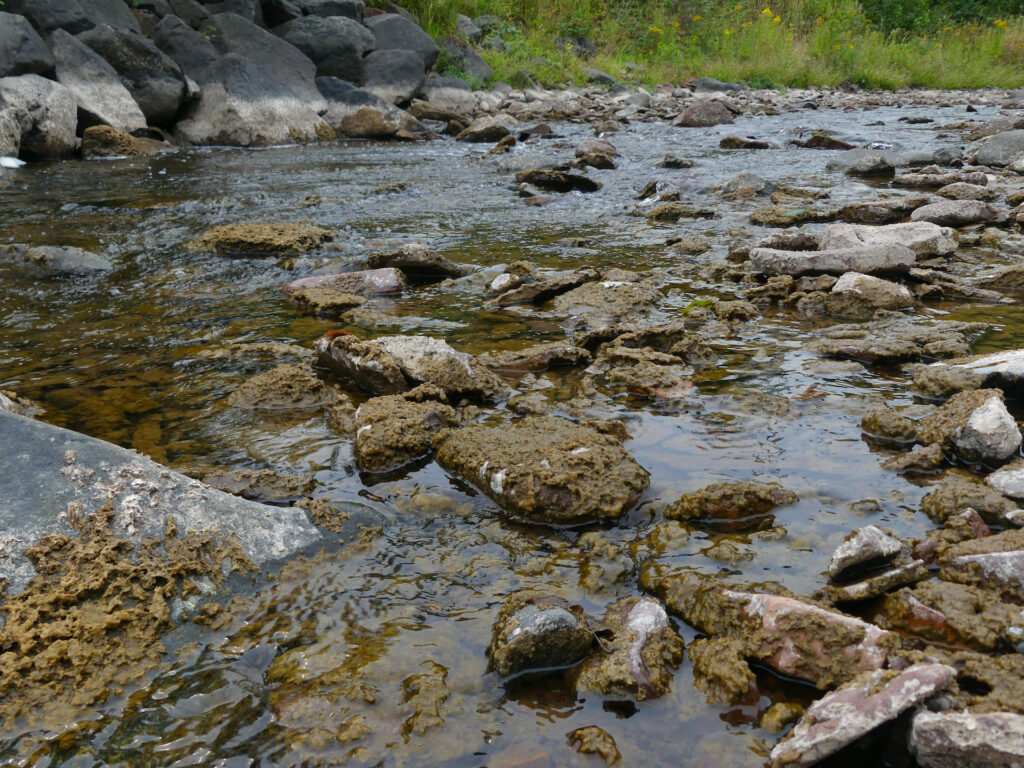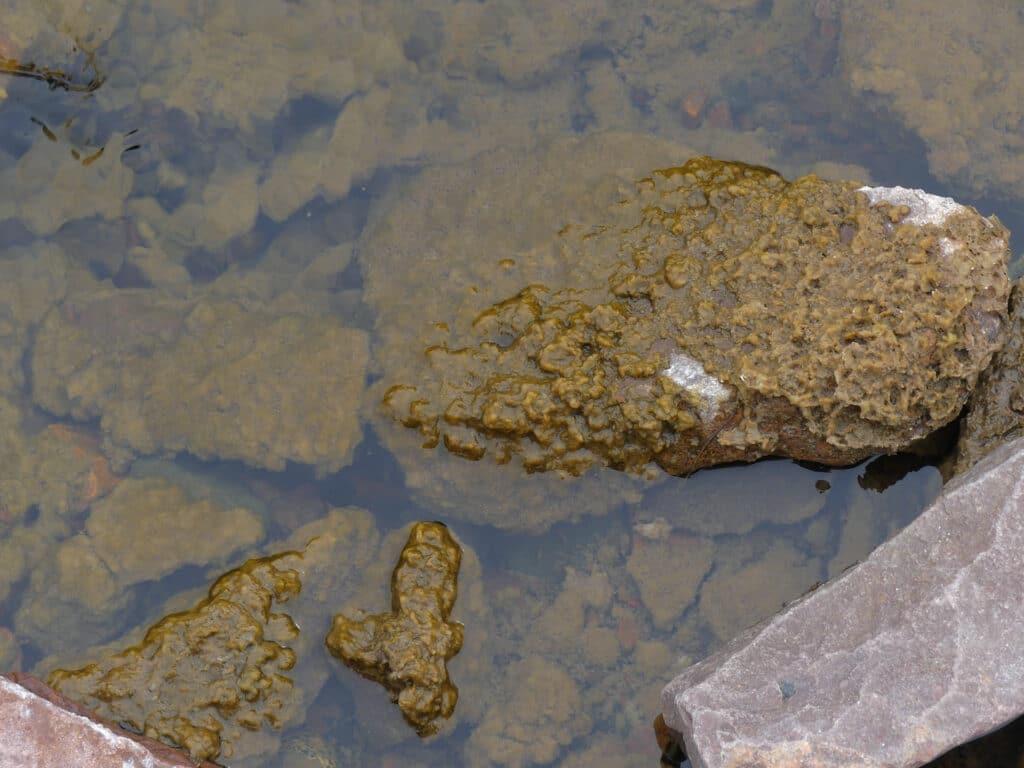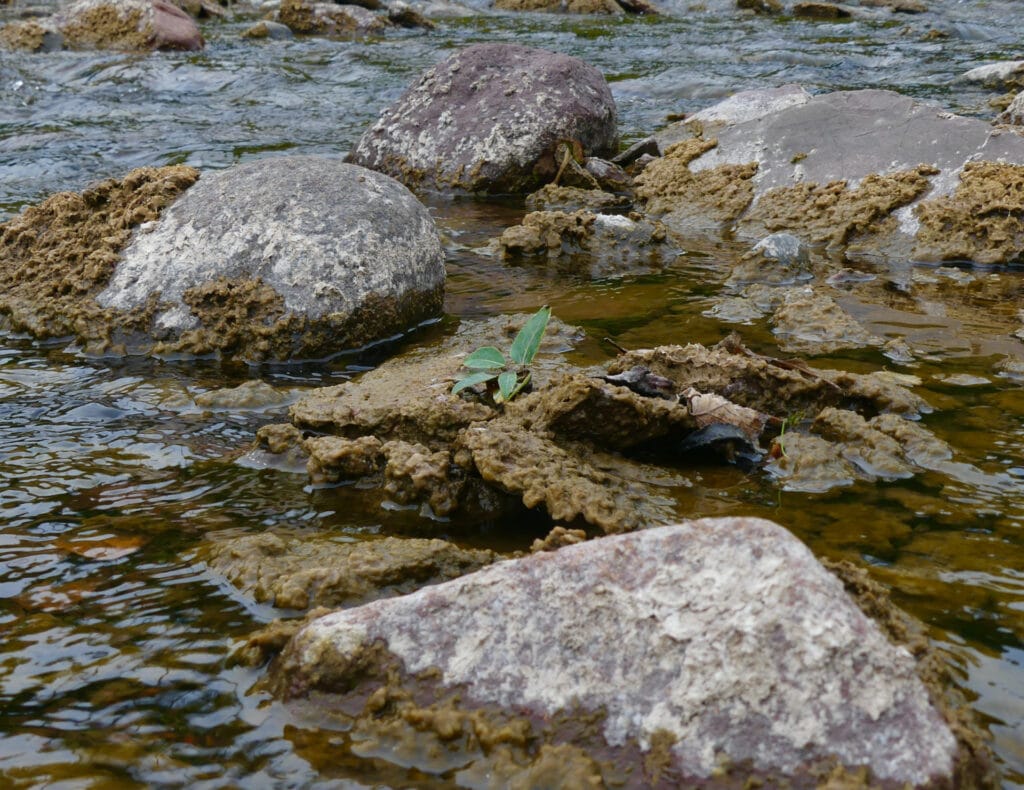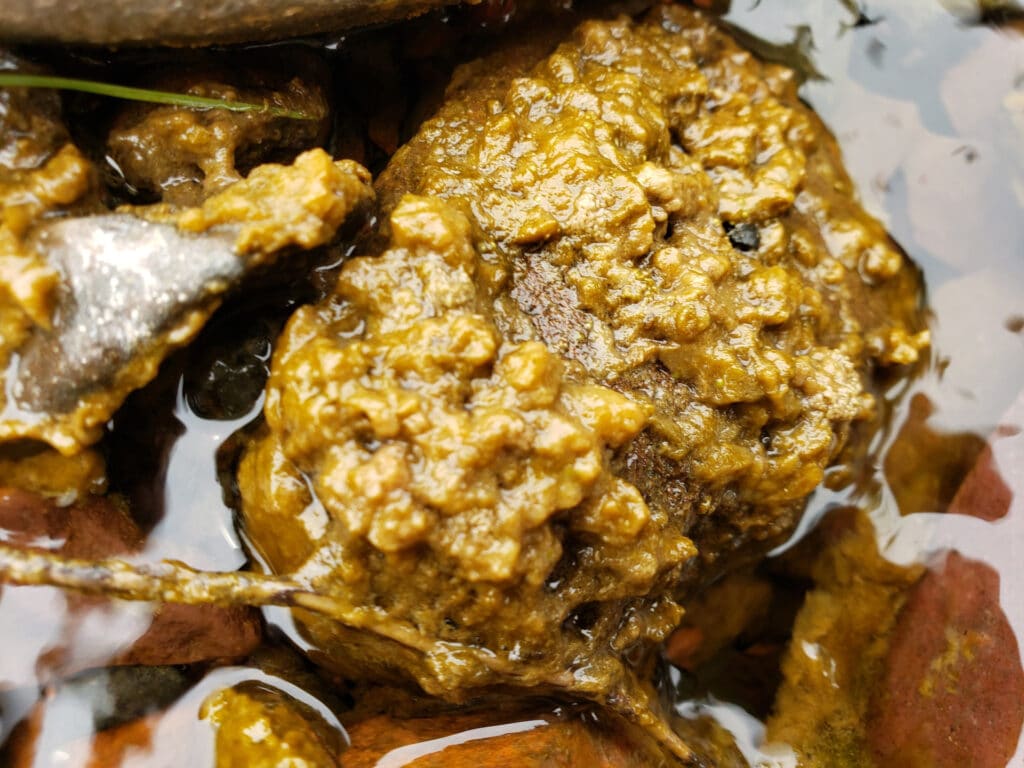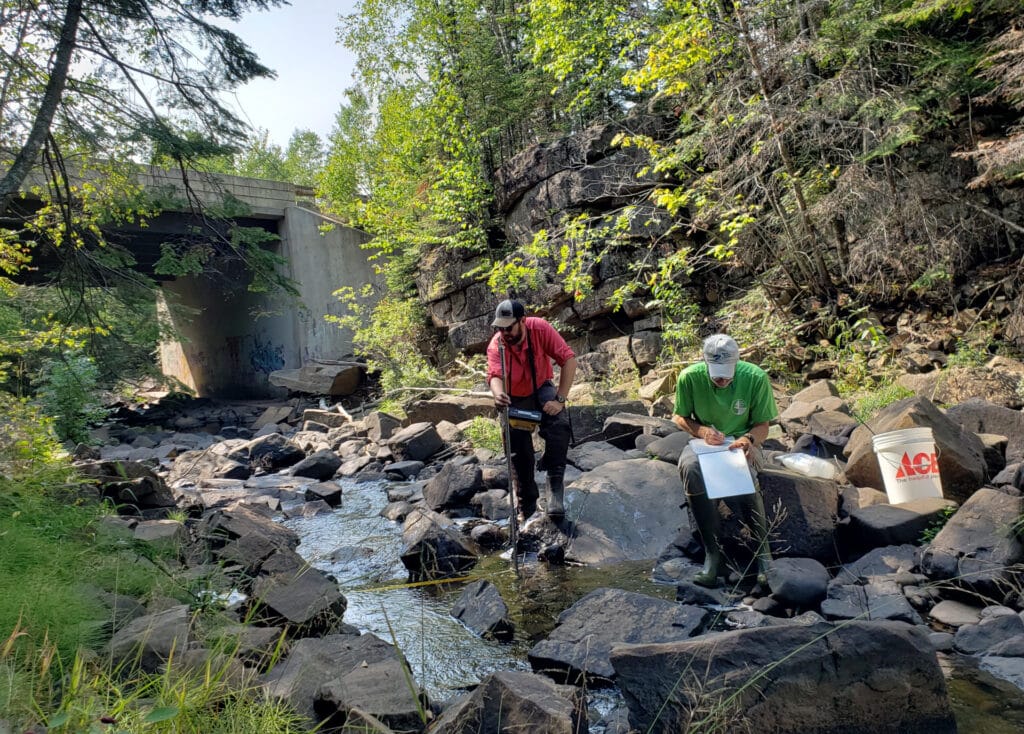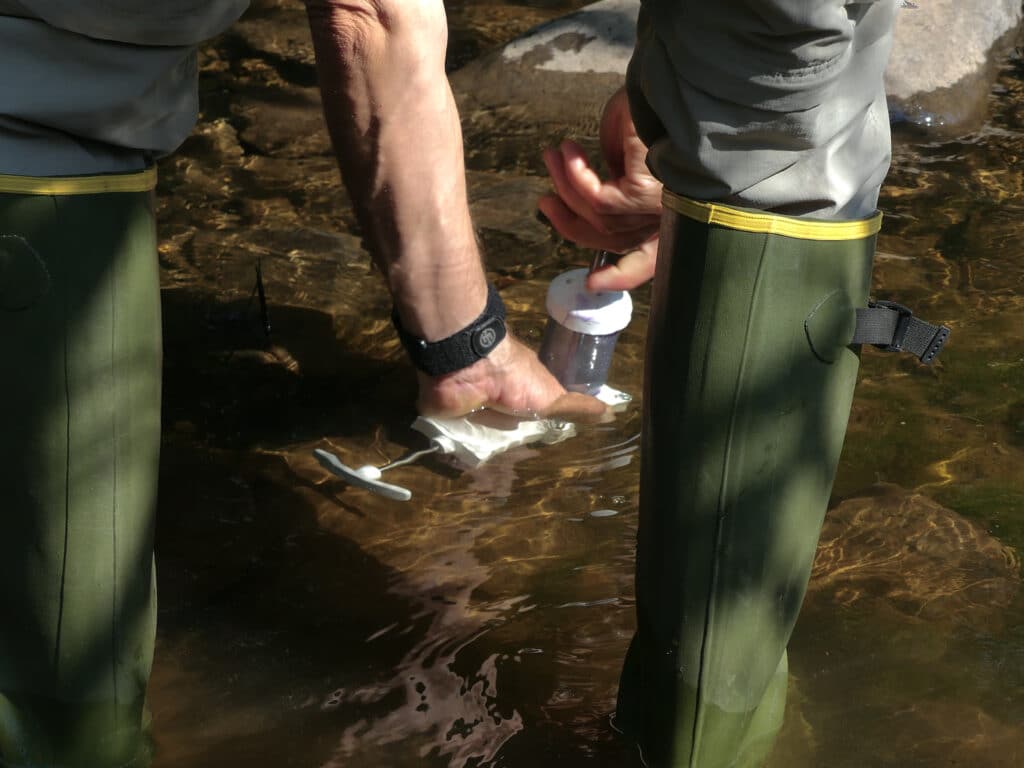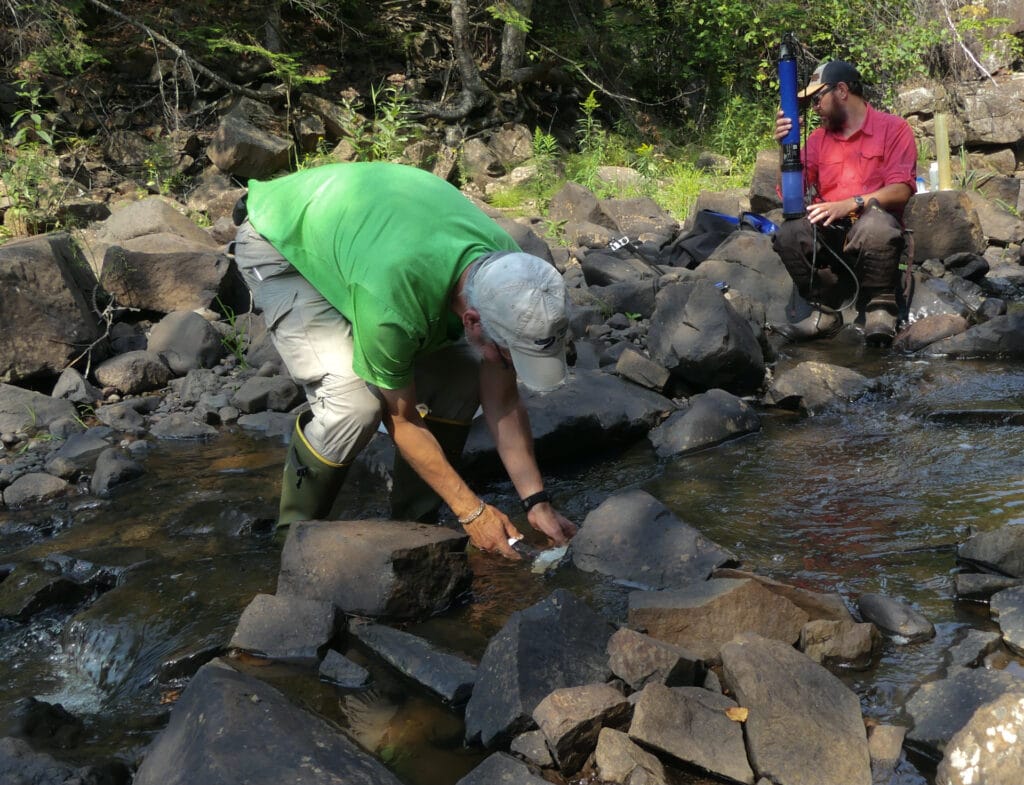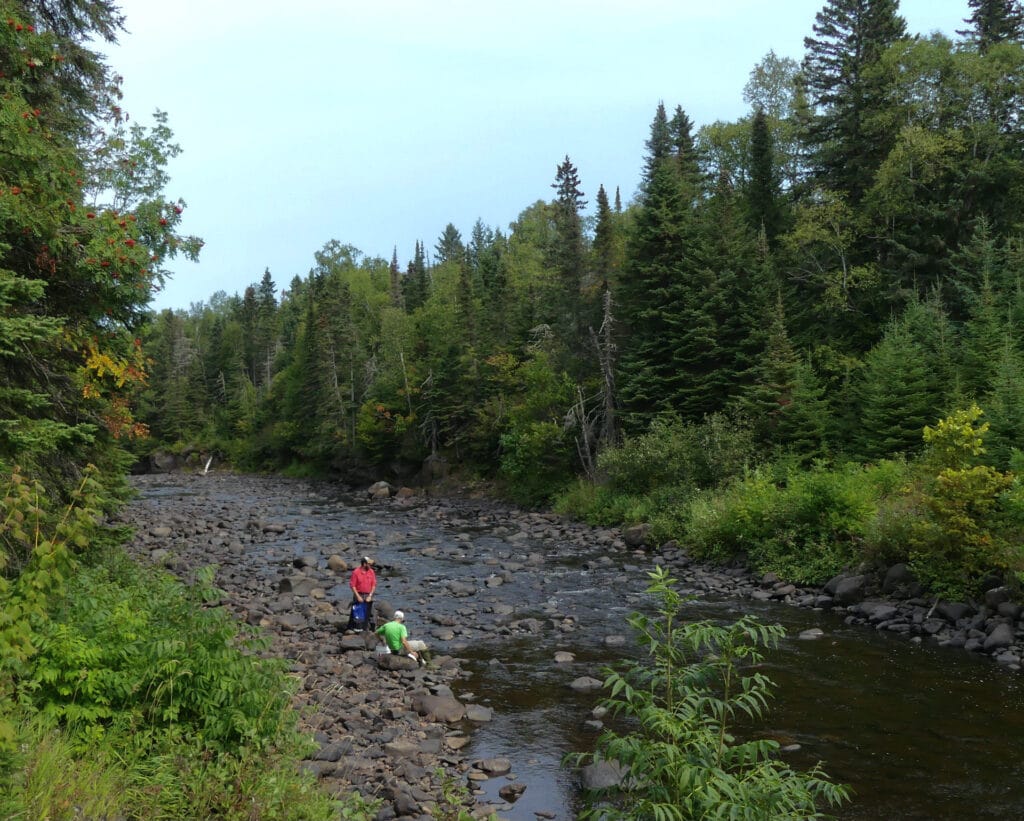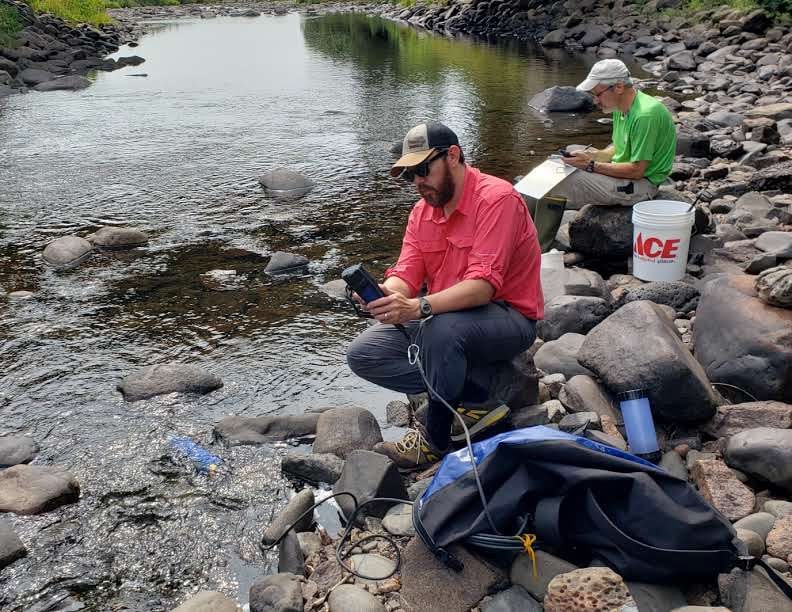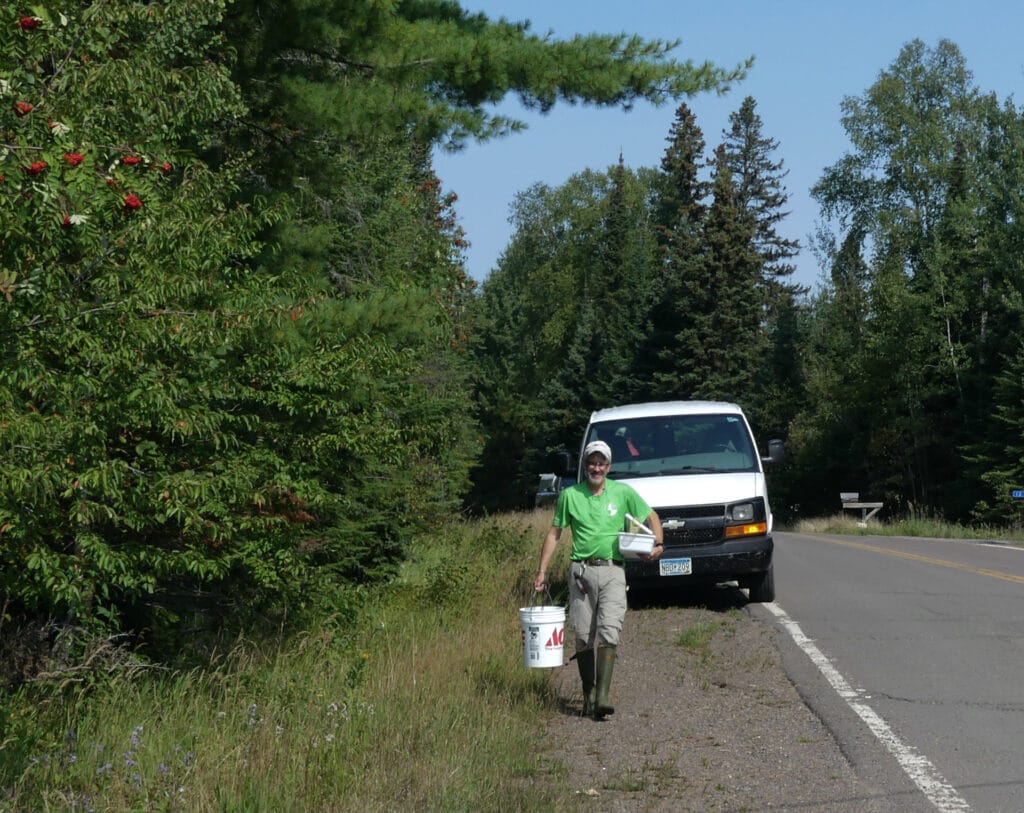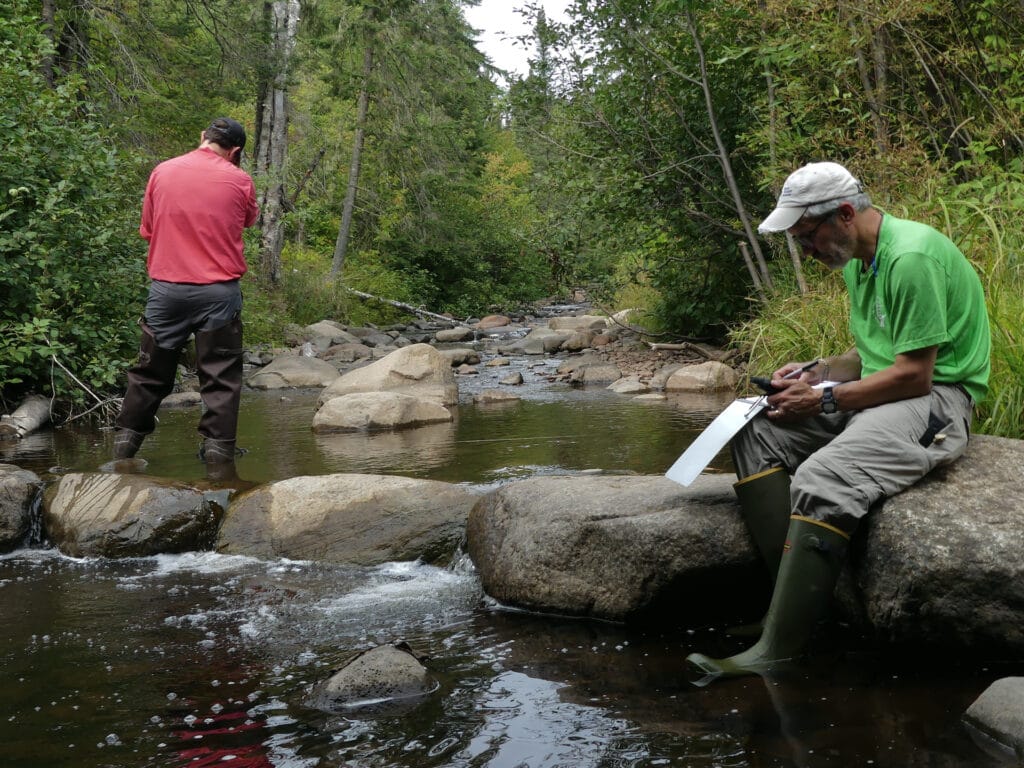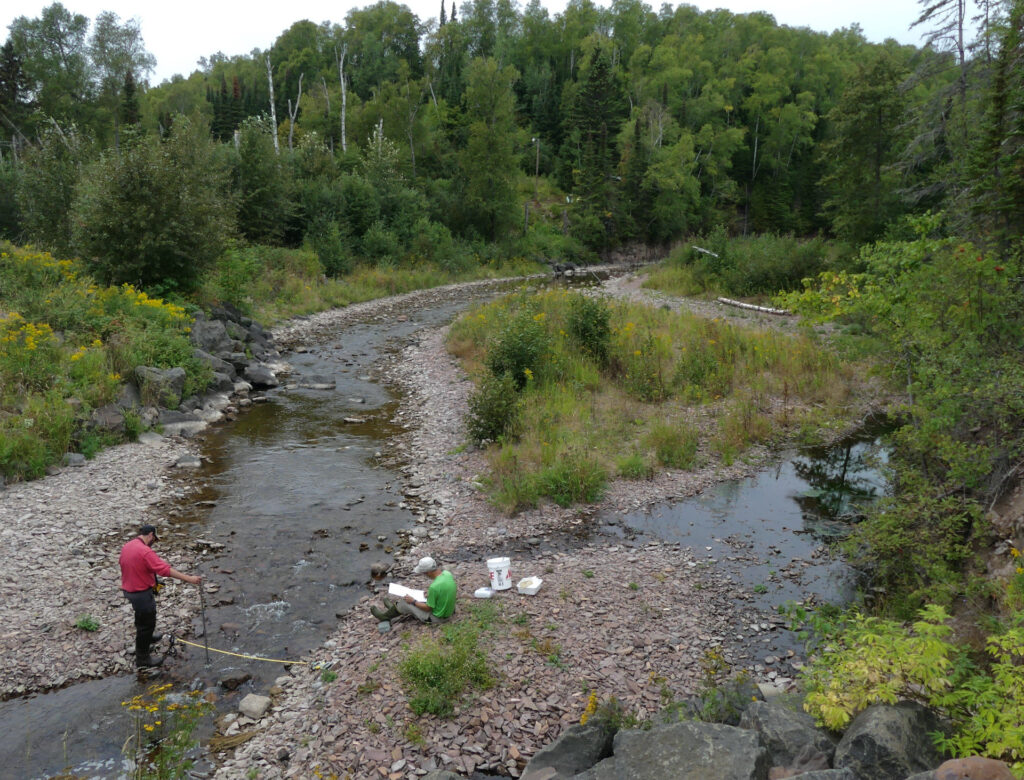
It was a cool and sunny morning in early September on the North Shore of Lake Superior when Adam Heathcote parked on the side of Highway 61, near a bridge. He and his research partner Mark Edlund climbed out of the van and gathered their gear, donning rubber boots and filling five-gallon buckets with equipment. Then they scrambled down the steep slope to a stream below and started another search for a significant new threat to North Shore streams.
For the next half hour, the pair of scientists took measurements of water quality, depth, flow, temperature, and more, and collected samples of water and algae. Then they got back in the van, cleaned all their gear, and headed for the next river.
At the end of a historically dry summer, the streams were mostly shallow and calm, seeming to trickle down their last rocky reaches to where they spill into the greatest Great Lake. The season’s last flowers wore dusty hues on the banks. Firefighting vehicles working nearby forest fires occasionally drove down the roads. Everything else was quiet.
Summer had been hard on the woods and waters of northeastern Minnesota. Drought gripped the region, leaving the rivers low and the forests highly flammable. Yet one organism might have enjoyed the weather: Didymosphenia geminata, a nuisance species of algae commonly called “didymo” or, most descriptively, “rock snot.” It can form dense mats of slimy growth that blanket rocks and the river bottom, damaging and degrading everything it touches.
That’s what Adam and Mark were hunting. The species has been in Lake Superior for at least 60 years, where it thrives in the cold, pure water, but doesn’t cause significant problems. People rarely see it because only the few and the brave step foot in Superior. But, only recently was it confirmed in the big lake’s tributaries, discovered in the Poplar River in 2018. This summer, the team confirmed it in seven more streams: the Caribou, Devil Track, Flute Reed, Kadunce, Kimball and Onion rivers, and Carlson Creek.
River killer
This unique aquatic plant seems to love drought conditions, because without rain, the little water left in the rivers is clear and pure, fed by groundwater, not nutrient-rich runoff. Most algae prefer warm water full of sediment and nutrients, but not didymo. By forming its dense mats, didymo can trap water and remove the oxygen, which helps it absorb the little available nutrient phosphorus, letting it thrive in such conditions.
“The same thing that makes it noxious is what allows it to thrive,” Mark says.
This cold, clear water is also preferred by trout, and didymo could destroy valuable habitat.
Didymo can be present in lakes without being a major nuisance, coexisting with other plants and animals and perpetually being beaten back by waves scouring the shoreline. But given the right conditions, it can be deadly for a river. It will take over habitat from other creatures, like aquatic insects that feed fish, or spawning trout, which require clean gravel river bottoms. It can also simply make a river unappealing and even dangerous for recreation, with slippery rocks driving away kids who want to splash around, or anglers chasing the streams’ salmonids and char.
The alga threatens the very things that are most loved and essential to Lake Superior’s wild and beloved tributaries.
That’s why last year, researchers with the Science Museum of Minnesota’s St. Croix Watershed Research Station and the Minnesota Department of Natural Resources launched an intensive two-year project. The Legislative-Citizens Council on Minnesota Resources recommended funding for the project from the Minnesota Environment and Natural Resources Trust Fund. Those involved feel a sense of urgency.
Researchers are trying to find out where the organism has spread, if a new strain of didymo is to blame, the conditions under which it thrives, and what the future might hold for North Shore rivers.
Stream study
The team spent several days this summer searching for didymo. Mark and Adam lived out of the van, and a hotel in Tofte. They woke up each morning and went sampling, and in the evenings, turned their quarters into a laboratory to study what they collected. The room smelled of mud, and gear hung drying everywhere.
One bright morning, the pair drove up Highway 61 nearly to Canada, starting the day’s search on the Grand Portage National Monument and working their way back. Adam drove while Mark juggled coffee, donuts, and maps. When they stepped out of the van at Grand Portage National Monument, the sun was glaring across the lake from the east, and someone was playing bagpipes by the water. It could easily have been one of the Scottish voyageurs who once frequented the site, but was actually a National Park Service interpreter.
Grand Portage National Monument is the site of one of the first Ojibwe settlements in Minnesota, and at the heart of the reservation today. The Ojibwe people now co-manage the National Monument in partnership with the National Park Service. Mark and Adam’s first stop was to meet with National Park Service biologist Brandon Seitz (no relation to author) to talk about the project and request permission to collect samples. Then they walked along the lake to tiny Grand Portage Creek.
As they studied the stream, an American redstart fluttered through the overhanging brush a few feet away, probably on its way south. Adam used a sensitive instrument submerged in the water to measure temperature and oxygen content. Mark used a device of their own devising to scrape algae off rocks and collect it.
“Didymo can hide out in a stream until conditions are right for a big bloom, and then explode in growth,” Mark says. “So it’s really easy to miss seeing it unless you’re lucky enough to be there at the right time, or if you look at samples under the microscope.”
In a well-practiced process, the pair recorded their data, stored the samples, and headed back to the van.
Didymo discovery
From Grand Portage, they made their way down the shore, stopping at more streams. For the first couple, no didymo was visible to the naked eye, but they took their samples and measurements and moved on.
At the Devil Track River, just a few miles northeast of Grand Marais, it was a different story. They could see it from the bridge. The whole river bottom was covered in greenish brown slime. Didymo had never been confirmed in the river before, but it was unmistakable now.
Adam measures stream flow while Mark records the data. Mark scrapes algae off a rock to look for didymo. In the background, Adam uses a special device to measure water quality. Adam and Mark get to work on another river.
“That’s what you don’t want to see,” Adam said, before heading down for a closer look.
While it was a disappointing discovery, the “rock snot” outbreak offered an important opportunity for the study. The scientists would measure conditions like stream flow and water temperature here, as well as all the other sites. By closely comparing the waters, some clues about what’s causing the problem might emerge.
The appearance in the North Shore’s rivers could be more of a matter of chance — and human activity. The algae can cling to boots, fishing gear, or anything else, and hitchhike to a river where it will establish a new foothold, putting everything downstream of its introduction point at risk. (Scientists can also carry it, and when they are walking in stream after stream all day, it’s important to prevent accidentally introducing it to a new river. The researchers carefully sanitized their gear after each stop.)
Intensive investigation
While Adam and Mark worked out of Tofte, another other pair of scientists supporting the research worked their way up the shore from Duluth: Heidi Rantala of the Minnesota DNR and David Burge, another Watershed Research Station scientist.
Over the next two years, the team will intensively study all the major Lake Superior tributaries of Minnesota’s North Shore. They will visit 20 streams once each year, and they’ll visit five additional rivers every month during the warm season.
The project also includes research right in Lake Superior. The crew collected samples and measurements along the lake’s rocky shoreline. Later, divers would venture farther off shore to gather samples from deeper rocks.
Collecting all this algae is intended to not only find didymo, but also to build a genetic picture of the problem. Burge has partnered with Dr. Robert Pillsbury at the University of Wisconsin Oshkosh to provide expertise in DNA analysis.
Adam and Mark collect and record data along a North Shore river. Mark processes an algae sample for later study. Heading down to another stream to seek out rock snot. Algae study site.
One hypothesis is that the didymo explosion is explained by a new strain of the algae, which could be more aggressive in North Shore streams. DNA will also help the researchers determine if didymo in the rivers is coming from Lake Superior, or from other rivers, near or far. And the scientists are genetically identifying the types of bacteria in didymo samples, and what this indicates about the algae’s impact on the ecosystem.
The project also needs help from the people who love and visit the North Shore rivers. The researchers are asking members of the public to report sightings of didymo to EDDMapS Midwest. This early detection database lets citizen scientists become important stewards.
Seeking a solution
After Mark and Adam were done at the Devil Track, it was time for lunch at a local restaurant overlooking the clear waters of Lake Superior. The setting was a subtle reminder of what is at stake. The North Shore’s streams are not only an important part of the region’s unique ecosystem, but also its economy. Tourism is a vital to many North Shore communities. People come for the lake, the small towns, the rocky hills, and the rushing rivers. Every degradation detracts from its draw to potential visitors.
“Coating a river bed in slimy algae would have a terrible effect on its health and appeal to people,” Heathcote says. “We have to figure out where didymo is and isn’t, where it’s coming from and how, and how we can control it and prevent it from getting introduced to more places.”
The didymo challenge on the North Shore is complex. It is likely driven by hydrology and climate, human behavior and natural processes. With passionate expertise from researchers, support from the state, and Minnesotans’ love of nature, the causes and cures of “rock snot” are being revealed.
More stories about this research and findings will be published over the coming year. This article is supported by a grant from the Quetico Superior Foundation and in partnership with the Science Museum of Minnesota. (All photographs courtesy Greg Seitz, Quetico Superior Wilderness News.)
More Information:
- St. Croix Watershed Research Station at the Science Museum of Minnesota
- Didymosphenia geminata USDA Invasive Species Information Center


